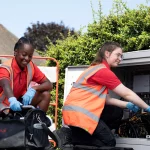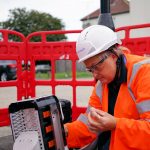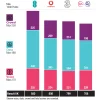Coverage of Gigabit Broadband Nears 88 Percent of UK in H1 2025

ISPreview has this morning published our biannual H1 2025 summary of UK fixed broadband coverage, which reveals that “full fibre” (FTTP) ISP networks have grown to reach 78.06% of premises (up from 73.53% in H2 2024) and 87.84% are within reach of “gigabit” 1000Mbps+ speeds (up from 85.87%). Read on to see details for England, Wales, Scotland and N.Ireland…
Just to recap. All the new gigabit-capable (1000Mbps+ or 1Gbps+) network connectivity added during the first half of 2025 has come from Fibre-to-the-Premises (FTTP) based networks via Openreach (BT), Nexfibre (Virgin Media), Hyperoptic, CityFibre, Netomnia (Brsk, YouFibre), KCOM, Gigaclear and many other alternative networks (Summary of UK Full Fibre Builds).
The reason why “gigabit” coverage is currently still higher than “full fibre” (FTTP) is down to the millions of premises still covered by Virgin Media’s older Hybrid Fibre Coax (HFC) network, which uses gigabit-capable DOCSIS 3.1 technology via a Hybrid Fibre Coax (HFC) network (there’s a lot of overbuild with FTTP in urban areas).
Advertisement
In addition, most of the progress on gigabit-capable builds seen during 2025 is still down to commercial investment (commercial builds have already delivered the first 80%+ of gigabit cover), often with only a little support from the Government’s various schemes. But the Project Gigabit scheme, and its subsidised rollout contracts with various different suppliers, are having an impact on this, albeit primarily via the hardest to reach premises (e.g. rural) that typically take longer to cover.
H1 2025 Broadband Coverage Figures
Listed below is the latest independent modelling from Thinkbroadband for late June 2025 (H1 – 2025). We should point out that the figure for ‘Under 10Mbps‘ doesn’t include any 4G mobile coverage (we only looked at fixed line services), which plays a part in the official Universal Service Obligation (USO) but isn’t included in TBB’s mapping. Sadly, it’s incredibly difficult to do an accurate model for mobile networks, especially in terms of a specific performance level.
Fixed Broadband Network Availability H1 – 2025
| Area | 30Mbps+ | Full Fibre | Gigabit | % Under 10Mbps |
| England | 98.48% (98.42%) | 78.24% (73.63%) | 88.54% (86.66%) | 0.51% (0.53%) |
| UK | 98.32% (98.22%) | 78.06% (73.53%) | 87.84% (85.87%) |
0.66% (0.70%) |
| Wales | 97.61% (97.42%) | 78.32% (73.13%) | 81.50% (77.72%) | 1.37% (1.43%) |
| Scotland | 97.06% (96.73%) | 70.20% (65.49%) | 81.89% (79.62%) | 1.65% (1.84%) |
| N.Ireland | 98.73% (98.61%) | 96.46% (96.06%) | 96.84% (96.46%) | 0.71% (0.76%) |
NOTE: It’s very important to remember that Government / political coverage targets, like the previous “85%” for gigabit by 2025, reflect a national average – this can of course be better or worse for some areas (e.g. some counties may achieve higher coverage, while others could be below that).
Take note that each region (Scotland, Wales etc.) may also have its own policy and targets, which will feed into the central UK coverage figure. Furthermore, it’s worth highlighting how much of an impact newer alternative networks (altnets) are having on all this – excluding coverage by Openreach, KCOM (Hull) and Virgin Media.
Advertisement
Altnets were found to have covered 42.26% of the UK with FTTP by the end of H1 2025 (up from 39.38% in H2 2024). This breaks down as 44.56% in England (up from 41.50%), just 18.82% in Wales (up from 16.89%), 33.95% in Scotland (up from 32.05%) and 41.08% in Northern Ireland (up from 39.29%). But the overall coverage improvement delivered from this will be reduced due to overbuild between so many networks, particularly in urban areas.
As stated earlier, this data is a modelled estimate and should be taken with a pinch of salt, not least because it won’t always reflect the very latest real-world position. But it’s still one of the best and most up-to-date gauges that we have for checking against official claims (Ofcom’s own data tends to be several months behind that of TBB’s).
Solutions for Slow Broadband Areas
Finally, those still stuck in sub-10Mbps speed areas will, at least for now, be left with little option but to try harnessing the flawed 10Mbps Universal Service Obligation (USO) via BT (UK-wide) or KCOM (Hull-only). Many of those who have pursued the USO say they were offered a mobile broadband (4G or 5G) connection via EE, but those considered delivered under the USO itself usually get full fibre (FTTP) lines.
However, the reality is that some people will find they live in areas where not even the USO can cover the colossal upgrade costs of getting FTTP (here and here). The previous government was in the process of examining support options for remote premises and had also been preparing to review the broadband USO (here), which may bring some changes in the future (the Labour Party previously called for a 30Mbps USO).
Advertisement
Failing that, consumers could either try waiting to see if the problem gets resolved or consider exploring the option of a LEO satellite service (Starlink is good, if you can afford it and look past the ‘Musk’ factor). We would also recommend that consumers check via Three UK / Vodafone and O2 (VMO2) to see if any of those deliver better 4G or 5G mobile coverage than EE in your area (ideally by conducting your own tests, since official coverage maps are fairly useless) – see our guide to external antennas.
Mark is a professional technology writer, IT consultant and computer engineer from Dorset (England), he also founded ISPreview in 1999 and enjoys analysing the latest telecoms and broadband developments. Find me on X (Twitter), Mastodon, Facebook, BlueSky, Threads.net and Linkedin.
« Study Claims 85 Percent of UK Broadband Users Suffer Connection Issues























































“It’s very important to remember that Government / political coverage targets, like the previous “85%” for gigabit by 2025, reflect a national average – this can of course be better or worse for some areas”
Project Giga#it still has no interest in rural Kent despite the taxes collected..
Taxation isn’t restricted to rural Kent.
Roll on covering the IV27 postcode, isn’t it stange how the big numbers are never caveated with holisic inclusive truths, just spining things to look good.
How about the % of each UK postcode covered ‘included, then the % of post codes etc? Duplications of suppliers (national waste), the availability vs actual take ups, etc Oh might not look so ‘good’?
Looking at https://labs.thinkbroadband.com it looks as though Lairg (the metropolis of IV27, popn 871) has some FTTP coverage. Even in a remote area such as yours, it is a numbers game.
Not sure if these folk can help you, https://highlandbroadband.com/tongue-fibre/